- This introduction includes aim of Siddha
medicine, Concepts of Siddha Medicine, 96
Thathuvankal,
Diagnostic Methods in Siddha system of Medicine and Treatment Modalities
in Siddha system of Medicine. It gives you an excellent insight into what is
Siddha medicine, its concepts and treatment methodology.
In our effort to share information on
Alternate Therapies we had shared articles on Ayurveda: The
Science of Life, What is common to
and difference between Ayurveda and Unani medicine, What is Orthopathy and Indian Origin of
Tibetan Medicine. eSamskriti is grateful to Ayurvedacharya
Dr G G Gangadharan for introducing us to the respected author. - Editor
Author is Dean,
National Institute of Siddha, Chennai.
Introduction
The art of medicine in this universe has
its origin even when the living organisms came in to existence in it. Though
various systems of medicine are in practice at worldwide, all systems have
their ancestral roots from nature only. It is nature which taught and provides
everything, not only to the human race but also to every life in this earth.
Hence forth, a system of medicine is not a
discovery, but it is a gradual evolution from nature with a long historical
development.
The ultimate goal of each life in this
world is to lead a perfect life and to unite with this nature. In other words,
each life has to get amalgamated with the perfect thing from which it
originated. But it is disturbed by obstacles like death, diseases, ageing,
wrinkling or shrinking of tissues of the body and greying of hair. Siddha
system paves the way for overcoming these obstacles in consonance with nature
and is one of the solutions to this endeavor.
“Health is Wealth” – a very common phrase of the common man which is in usage for centuries. Though it appears simple, it gives valuable meaning, imparting significance to the healthy way of living. Keeping this in the background, different civilizations and cultures have developed their own system of medicine. Siddha system of medicine is also one of the pioneering systems which developed among the Dravidian civilization and culture.
The “Tamils" who inhabit the Southern Peninsula of the Indian sub-continent undertook a systematic analysis of nature and its elements and developed a highly systemized medical system which is now known as “Siddha system of Medicine”. Medicine is not merely a science of experiments, but an art of nature. Generally, this system is full of treasures given by a number of spiritual scientists, called “Siddharkal”. They are the founders of this system. They had realized that if the body could be made strong and perfect they could get rid of birth, death and diseases.
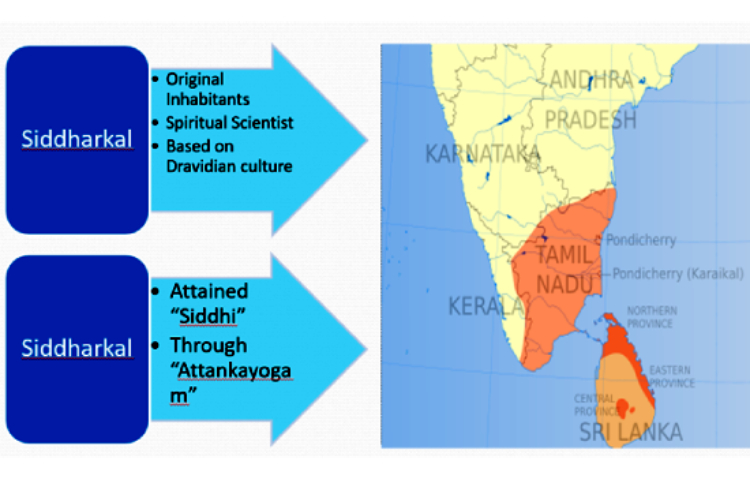
Siddha system of Medicine has derived its name from the root word, “SIDDHI”, which gives the meaning “Perfection” or “Eternal Bliss”, which is the ultimate goal of life to be achieved. Siddharkal
are those people, who had achieved this goal by attaining eight types of siddhikal (Attama siddhikal – eight fold supernatural powers - Anima, Mahima, Lahuma, Karima, Prabthi,
Prakamiyam, Vasithuvam, Easathuuvam) through
eight types of yogic practices (Attanga yogam – Iyamam, Niyamam, Athanam, Pranayamam, Pratiyakaram, Tharanai, Thiyanam, Samathi).
They believed they could achieve “Eternal Bliss” with the help of physical body and they tried to get rid of the obstacles of life. They learnt many truths and facts from Nature which they practised in their life and achieved their goal. Since they achieved Siddhi, they were called as “Siddharkal”. Hence, Siddha system of Medicine is a by-product of Siddhar’s aim of achieving Eternal Bliss. Siddhar’s hallmark tenets are-
i) control over breath,
ii) control on sex energy and
iii) control over mind.
Siddhars were well aware that the
physical body alone is the only instrument to achieve eternal bliss, to unite
with the Lord. But it is transient and is easily susceptible to get diseases
and sufferings which may be an obstacle to attain GOD. The regular practice of
attanga yogam helped them to raise the quality of GOD hood in them and made their
body immortal to attain their ultimate aim.
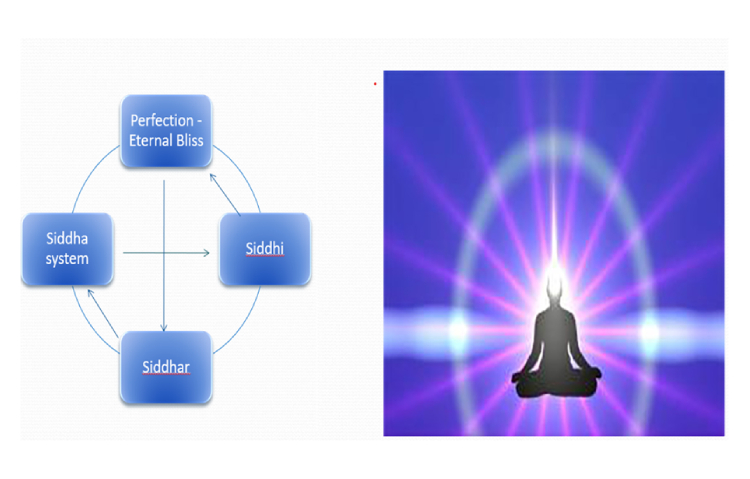
As the definitive aim of
Siddhars was to achieve perfection of the body and soul, they tried to achieve
it through the following ways;
1. Universal love
2. Yogic practices
3. Mani (mercurial
amalgamations)
4. Mantiram
(incantation)
5. Oudatham
(Medicine).
The term “Maruthuvam” is derived from the root word “Marundhu” (Medicine) which has the following synonyms, viz., cure, antidote, management, treatment, medical practice etc., The definition for “Marundu” (Medicine) is described in such a way that the thing which heals and prevents not only the physical and psychological ailments, but also death.
In this path also, Siddha system of Medicine aims for immortality and hence the system is a complete Medical system.
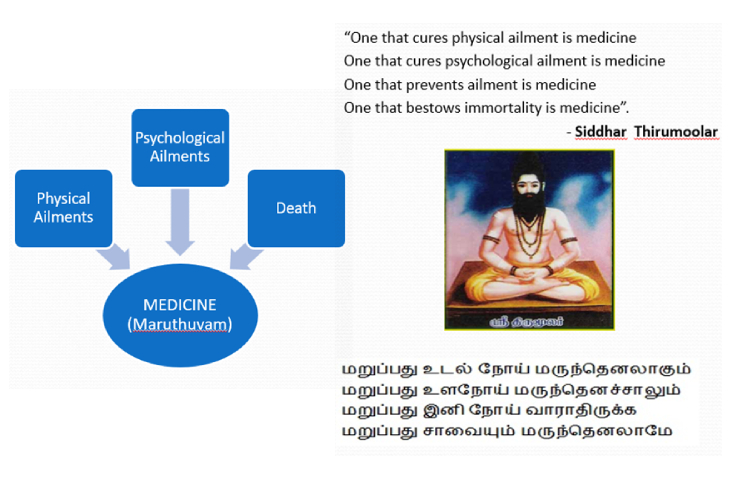
Siddha system of medicine describes health
as a state of happiness which is free from sufferings. The happiness and the
sufferings are because of the twin Karmic deeds of good and evil of the living
beings in this world. Sufferings are caused by two factors which may be either
internal or external. Both happiness and the sufferings are experienced by the
living body i.e. the body with the life force (soul).
In other words, it is the life force and
physical body, acting together, that acknowledge or enjoy the pleasure and pain
of life. Prevention, cure and contentment are the
three main goals of the Siddha system of Medicine to the mankind. Hence,
the system is aiming at happiness by removing the sufferings which is driven
towards the complete health.
Siddha system of Medicine emphasizes more
on a system that primarily focuses for a healthy and promotive livelihood by
eliminating the sufferings, diseases etc., Furthermore, healthy living is
pointing out not only the physical health but also the social, psychological
and the spiritual wellbeing of humanity.
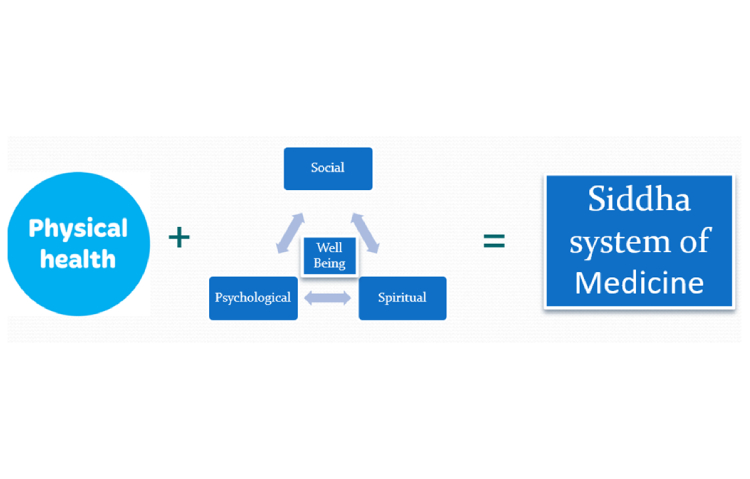
Concepts of Siddha MedicineSiddha system of Medicine is based on 96 Thathuvankal (96 Philosophies) which are
considered to be the basic principles. These 96 principles are universal to all
particularly the human beings. These 96 principles and their functions are
responsible for the physical, mental, intellectual components of our body.
Literally, these form the anatomy and physiology of human beings according to
Siddha system.
Among these principles, the Iymboothangal (Five elemental theory), Mutthathukkal (Three humoral theory), Ezhu Udal Thathukkal (Seven body
constituents), Aaru Suvaikal (Six
tastes) are the most vital principles based on which the Siddha system of
Medicine laid its foundation and spreads its uniqueness for the wellness of
humanity. Though its age was dated back even to the origin of civilization, the
principles of this system are serving the society of scientifically mastered
people. These principles may even be applicable for the generations to come in
future also.
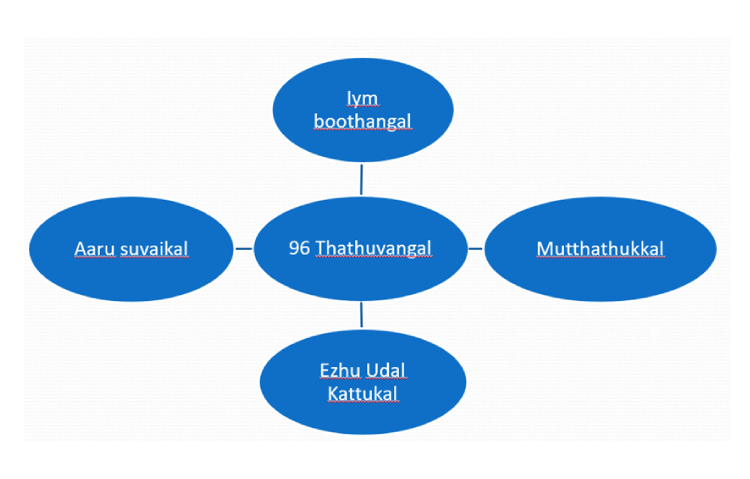
Iymboothangal Theory (Five Elemental Theory):
Every worldly object in this universe,
either living or nonliving, are formed by classical basic elements that are
five in number. They are-
1. Nilam
(Earth)
2. Neer
(Water)
3. Thee
(Fire)
4. Vayu
(Wind/Air)
5. Vinn
(Space/Ether).
and are called as “Iymboothangal” and they are combined with one another or each other in a predetermined different permutations and combinations to form the earthly things. These undergo the following processes viz., Creation, Protection and Destruction thereby maintaining the vicious cycle of nature.
All the creations of the world including the human body are made up of these five basic elements and that upon destruction or death of these creations; disintegrate again in to these five elements. This is the base for the Siddhar’s view of “Ullathu pokaathu, Allathu Vaaraathu” which means nothing is created nor destroyed. Each of the five elements is associated with one of the five senses and acts as the gross medium for the experience of sensations.
The five basic elements are existed or
exhibited in two different forms. They
are,
1. Gross state
2. Subtle state
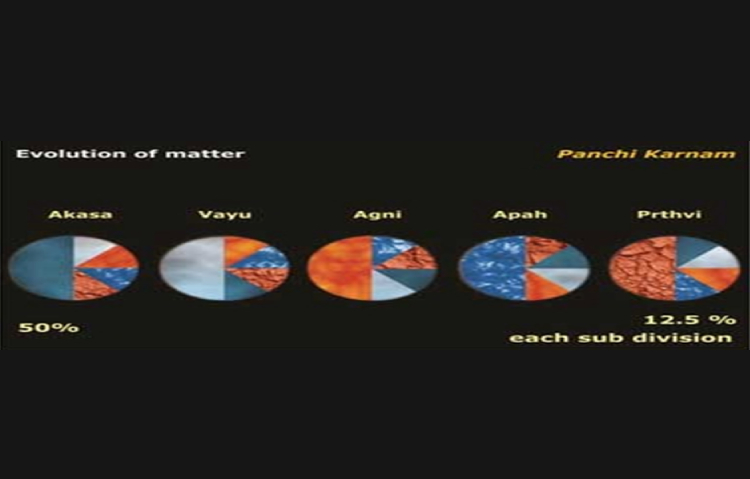
Gross state elements are recognizable and
subtle state elements are not perceivable. These five basic elements are
initially formed as primordial elements in subtle form. The subtle state
elements are formed from one another in the following order,
Vinn –> Vayu –> Thee –> Neer –> Nilam.
Then, they manifest in to its gross state and become visible. The manifestation of the five elements from the subtle state to the gross state is called as “Pancheekaranam”. As the grosser state elements combine one another, all the objects in the universe form with a definite shape and characteristic feature, which constitutes the Macrocosm.
Similarly, the human body (Microcosm) is
also constituted by these five elements into his seven physical body
constituents (saaram, cheneer, oon,
kozhuppu, enbu, moolai, sukkilam/suronitham), three biological humours (vali, azhal, iyam) and also the food we
consumes to nourish them.
Again, the reproductive
physiology of human being is also explained on the basis of these five
basic elements as follows,
The semen (vindhu) is the combination of vali
and thee while the ovum (naatham) is neer. The uterine wall where the
fertilized ovum gets implanted is nilam
and the uterine cavity where the fertilized ovum grows is the vinn.
Thus, the five basic elements are the
basis of the Macrocosm and the Microcosm and hence any changes in the Macrocosm
(Universe) will also be reflected in Microcosm (human body). In other words,
the physiology, the pathology, diagnosis, pharmacology and the treatment in
Siddha system of Medicine are based on these five basic elements.
Mutthathukkal
theory (Three humoral theory)
The Siddhars have found that there is integrity
between the functions of the Macrocosm (Universe) and Microcosm (Human Body)
and are relative to each other. They called it the Three humors i.e. Vali, Azhal and Iyam. These three basic factors are responsible for the functional
integrity between the environment and the living ecosystem. The three processes
viz., creation, protection and destruction can be attributed to these three
basic factors respectively.
It is again the five basic elements that
unite in the following way to form these three humors,
Vinn + Vayu = Vali
Thee =
Azhal
Neer + Nilam = Iyam
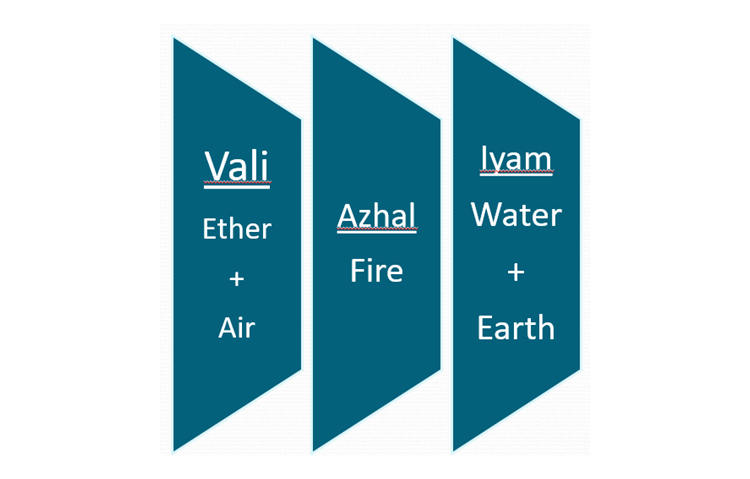
These three humors along with the other
remaining 96 principles constitute our body. When these three humours are in
equilibrium or in normal state, they are called as “Uyir Thathukkal” and maintain our body physiologically. When the normalcy or equilibrium is altered, then it leads to pathological conditions and at that time, these factors are called as “Kutrankal”.
Briefly, it can be concluded that these
three humors rule our body biologically and alter it pathologically.
Siddha system of Medicine explain the uyir thathu Vali as the creative factor and is attributed to the first phase of
human life, Azhal as the protective
factor and is attributed to the middle phase of human life and the Iyam as the destructive factor and is
attributed to the last phase of human life. These three factors are nourished
by their respective elements in the food what a man consume.
Though these three humors are the life
forces that drive our body healthy, Vali
predominantly exists below the naval, Azhal
between the naval and the thorax and Iyam
in the head and neck regions.
The three humors combine among themselves
in nine different combinations in such a way that one of the humors might be
more and the other might be less. Not only that, the predominance of a
particular humor may be constituted at the time of fertilization that results
in the temperament of a particular person accordingly. In this way, the
following temperaments are described in the Siddha literatures-
1. Vali
2. Azal
3. Iyam
4. Vali
Azhal
5. Vali
Iyam
6. Azhal
Vali
7. Azhal
Iyam
8. Iya
Vali
9. Iya
Azhal
10. Mukkutram
The body constitution of a person must be
taken into account during diagnosis, treatment, diet planning, seasonal
environmental changes etc.
These Uyir
Thathukkal Vali, Azhal and Iyam are further subdivided individually into 10,
5 and 5 subdivisions respectively depending upon their physiological functions
exerted by them in our body.
If the three humors remain in their sites
in the body it is known as the natural state of the humor (Thannilai). When the humors increase or aggravate in their sites
individually, it is the state of aggravation (Thannilai Valarchi). When the humors aggravate not only in their
sites but also in their adjacent sites, then it is called as state of
aggravation of humor in neighboring sites (Vetrunilai
Valarchi). These variations are attributed to factors like food,
activities, daily and seasonal variations. Vali
is aggravated in its sites during summer, influencing the other humors during
monsoon and is normal during spring. Azhal
is aggravated in its sites during monsoon, influencing the other humors during
spring and is normal during early winter. Iyam
is aggravated in its sites during late winter, influencing the other humors
during early summer and is normal during late summer.
In the universe, three factors that
maintain the ecosystem are the sun, the moon and the wind. Vali is represented by the wind which is responsible for the
movement is a combination of Vinn and
Vayu. Azhal is represented by the sun
which is responsible for energy of conversion and is formed by Thee. Iyam is represented by the moon which is
a cooling agent formed by the combination of Neer and Nilam.
Aaru Suvaikal
Theory (Six tastes theory)
The things or objects in this universe
are all the products of the five basic elements and are existing in different
forms i.e. living or non-living. Human beings can identify them through their
sensory organs. These sensory organs function through the five basic elements
as described in the following table.
|
Elements
|
Gnana Inthriyankal – Iym Porikal (Sensory
organs)
|
Iym Pulankal (Senses)
|
|
Nilam
|
Mooku (Nose)
|
Naatram (Smell)
|
|
Neer
|
Naakku (Tongue)
|
Suvai (Taste)
|
|
Thee
|
Kan (Eyes)
|
Oli (Vision)
|
|
Vayu
|
Mei (Skin)
|
Ooru (Touch)
|
|
Vinn
|
Sevi (Ear)
|
Osai (Sound)
|
From this table, it is clear that the bond
between man and worldly things is established by the five basic elements
(Iymboothankal) only. Siddhars have utilized the sense of taste in most of the
times to identify the drugs for treatment. Not only that, the taste sense also
provides certain diagnostic criteria to identify the diseases of the person.
With this background, the Aarusuvaikal theory (six tastes theory) plays a vital
role in Siddha system of Medicine.
Siddha system of Medicine classified the
tastes into six types viz.-
1. Inippu
(Sweet)
2. Pulippu
(Sour)
3. Uvarppu
(Salt)
4. Kaippu
(Bitter)
5. Kaarppu
(Pungent)
6. Thuvarppu
(Astringent).
Each taste is the result of combination
of two basic elements as that of the three humors. The formation of six tastes is
explained below.
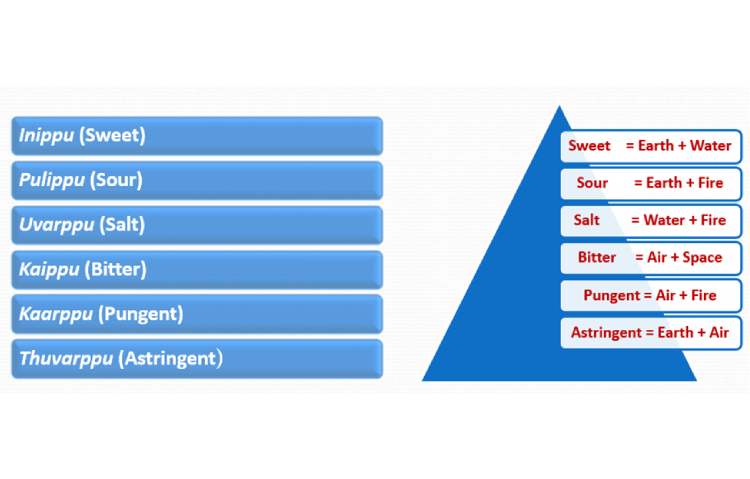
The relationship between
Six Tastes and Three Humors
|
Humors
|
Promoting Tastes
|
Pacifying Tastes
|
|
Vali
|
Pungent, bitter, astringent
|
Sweet, sour, salt
|
|
Azhal
|
Sour, salt, pungent
|
Sweet, bitter, astringent
|
|
Iyam
|
Sweet, sour, salt
|
Pungent, bitter, astringent
|
The promoting and pacifying tastes of
each and every humors are classified based on the combination of the five basic
elements in both tastes and humors and its relative property with each other.
This forms the basis for the treatment plan for a disease in Siddha Medicine. Moreover,
depending upon the presence of the element Thee
(fire) in an object, the things and tastes can be further classified in to two Veeriyams (potencies), viz., Veppam and Thatpam. The objects that have predominant Thee element are usually having salt, sour and pungent tastes and
are classified under veppa veeriyam
(Hot). The others are brought under thatpa
veeriyam (Cold).
Concepts about Diseases
According to Siddha system of Medicine,
diseases are caused due to imbalance in the normal ratio of three humors (Vali, Azhal and Iyam). The ratio is altered by the food and activities of the person
and due to the changes in the environment.
Not only the derangement of three humors,
the astral influences, poisonous substances psychological causes, spiritual
causes are also the important factors for the occurrence of diseases. Siddha
system of Medicine identifies the diseases in to 4448 numbers. These diseases
are broadly classified on the basis of three humors as Vali noikal, Azhal Noikal and Iya
Noikal. Further the diseases are sub classified into many types on the
basis of various factors like treatment modalities, clinical features,
anatomical locations etc., Additionally, the diseases are classified into Saathiyam (curable), Asaathiyam (incurable) and Arithil theerum (curable with extra
efforts) based on the prognosis of the diseases.
The changes that occur in a disease are
taking place in a sequential order. Initially, a particular humor increase or
decrease in its site (thannilai piralthal)
which influences the other humors (vetrunilai
valarchi) to produce the premonitory symptoms (murkurikal). Later on, the specific signs and symptoms are
exhibited. If the disease is properly treated at this stage, the deranged humor
is turned back to its normal state (thannilai
adaithal) and the symptoms disappear. If it is left untreated or ignored,
the complication of the disease results which leads to a state called mukkutra nilai or sannipatham.
Diagnostic Methods in Siddha
system of Medicine
Diagnostic methods in Siddha medicine is
divided into three as follows-
1. Examination by the sensory organs (Poriyal arithal)
2. Examination by the senses (Pulanaal Arithal)
3. Examination by interrogation (Vinaathal).
The Physician examines the patient using
his sensory organs and senses and arrives at a diagnosis. He also interrogates
the patient about the history, duration, symptoms etc., to diagnose a disease.
The system approaches the patient in a
unique method of using eight fold diagnostic tools like Naadi (Pulse reading),
Parisam (Palpation), Naa (Tongue
examination), Niram (Complexion), Mozhi (Speech examination), Vizhi (Eye examination), Malam (Faeces examination), Moothiram (Urine examination). Apart from these tools, the system has described the clinical features of each and every disease clearly in various Siddha texts and a specialised unique technique called “Manikkadai nool” which measures the wrist of the patient interpreting the disease by which a man is affected. The urine examination in Siddha Medicine is unique and it consists of two parts i) characteristics of urine in different diseases (Neerkkuri)
and ii) examination of urine by instilling a drop of gingelly oil on the
surface of the urine (Neikkuri).
In neerkkuri,
the following factors are to be noted, 1. quantity, 2. colour, 3. froth, 4.
odour and 5. specific gravity. In Neikkuri,
the pattern in which the instilled oil drop spreads paves the way for
diagnosis and prognosis of a disease. Generally, if the instilled oil drop
spreads like a snake, it indicates the presence of Vali disease in the body. Similarly, the shape of a ring indicates Azhal disease and pearl like appearance
indicates the Iya disease in the
body.
Apart from these, examinations of the
saliva, semen have also been explained in this system for diagnostic and
prognostic purposes.
Pulse reading in Siddha system is called as “Nadi
paritchai” which an important diagnostic tool is providing lots of information to the Physician. It is a non- invasive technique of Siddha method of diagnostic tool in practice. Though it requires very high expertise and knowledge, it can be used as an inexpensive and quick method for diagnosing a disease at bedside. Usually the radial pulsation is read by the Physician for diagnostic purposes. But Siddha texts have
described nine more sites in our body where pulse can be read. They are-
1. Inner side of the ankle
2. Genitals
3. Umbilicus
4. Chest
5. Ears
6. Nose
7. Neck
8. Eyebrows
9. Scalp

The naadi is felt through the three fingers of the examiner which is placed over the radial artery (wrist) just one inch below the thumb along the lateral border of the hand of the patient. The pulsation on Physician’s index, middle and ring fingers indicates the vali, azhal and iya naadi respectively. The
pulse is examined in the right hand of males and the left hand for females. The
units of measurement for vali, azhal
and iyam are 1: ½ : ¼ respectively which is found in a healthy person. The unit is equivalent to the size of a grain (wheat). Alteration in this ratio indicates the presence of diseases in the body.
Treatment Modalities in
Siddha system of Medicine
The treatment methods in Siddha system is
focusing at complete restoration of the deranged humors into its normal
physical state or in equilibrium. Appropriate food and performing activities
according to daily and seasonal regimen of lifestyle are the prime aim in
treating the diseases. Then selection of medicines based on six tastes, three
humors and five elemental theory is vital to treat the diseases. The treatment
must be initiated as soon as the cause and the course of the disease are
assessed.
In order to restore the deranged humors
to its normal state, various cleansing therapies are recommended specifically. It
is otherwise called as detoxification process. They are-
1. Purgative Therapy – To neutralize the deranged Vali
2. Emetic Therapy - To neutralize the
deranged Azhal
3. Nasal instillation and Collryium application – To neutralize the deranged Iyam.
Apart from the above mentioned therapies,
there are some more cleansing therapies are described. They are-
1. Fasting therapy – To treat all types of fever
2. Steam therapy – specific preparations indicated for specific diseases
3. Oleation therapy – specific oil preparations indicated for specific ailments
4. Solar or heat therapy – Diseases connected with vali humour
5. Blood-letting therapy – Conditions of accumulated blood
6. Physical therapy – Used mainly in vali diseases performed in 9 different
ways.
The significance of cleansing therapies
is aimed at the elimination of excesses and toxins from the body, restoration
of the natural processes through vital forces and reduction of the duration of
treatment. Even the dosage required for a particular disease can also be
reduced if prior cleansing therapies are performed. Cleansing therapies are cost
effective approach in treatment modalities.
Following the cleansing therapy,
pharmacotherapy with drugs and surgical methods are recommended according to
the condition of the diseases. These therapies are further classified into-
1. Deva
maruthuvam – Divine treatment
2. Manuda
maruthuvam – Rational treatment
3. Asura
maruthuvam – Surgical treatment.
1. Deva maruthuvam – Divine treatment:
In this treatment, medicines like parpam, chenduram, chunnam, kattu, kalangu,
guru, kuligai prepared using mercury, sulphur, pashanams are given. Mostly higher medicines (Uyar marundhukal) are used to treat chronic diseases which are not responding to other modalities. The medicines prescribed are inorganics that follow strict SOP’s during preparation including the purification of raw drugs.
2. Manuda maruthuvam – Rational treatment:
In this treatment, mostly the herbal
medicines are used to initiate the baseline treatment in the beginning stages of
disease. The medical preparations like churnam,
kudineer, charu, surasam, legyam, manappagu, mathirai, thylam etc, are
prescribed as drug of choice.
All the 32 types of internal drug
dosage forms described in Gunapadam
(Pharmacology) text are being included in these two treatment classifications
which may also include some of 32 types of external medicines in Siddha like pattru, ottradam, poochu, kattu, pottanam, podithimirthal, mai, etc.,
3.
Asura maruthuvam – Surgical treatment:
Surgical procedures in Siddha system indicated
for diseases which are not cured alone by internal medicines are included in
this treatment. About 25 procedures are given in this classification. It is
further subdivided in to three categories viz.-
1. Aruvai or Surgical application
2. Agni or Heat application
3. Karam or Caustic application.
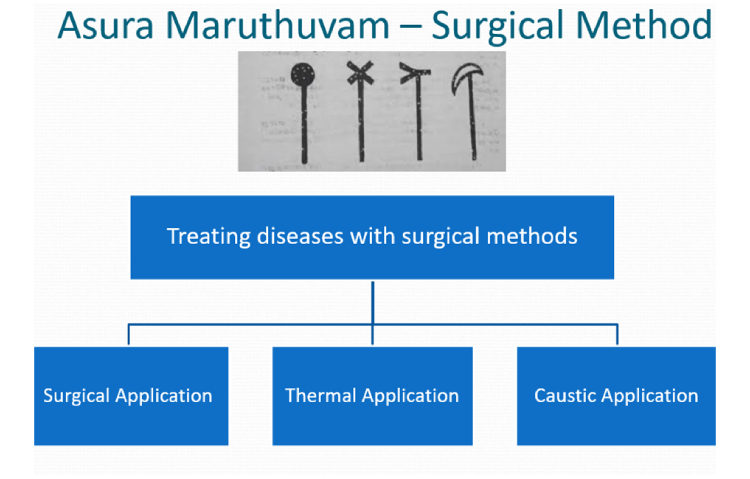
1. Aruvai or Surgical
application:
Performing surgical procedures with 26
types of surgical instruments like knife, blade, ear scoop, forceps, etc.,
About 13 types of surgical procedures are explained under this application.
They are-
1. Aruvai or Excision
2. Keeral or Incision
3. Kuruthivangal or Blood letting
4. Attai vidal or Leech application
5. Salagai idal or Probing
6. Vardhi vaithal or Inserting medicated
cloth pieces or Medicated wicks
7. Oothal or Blowing method
8. Peechal or Enemanormal
9. Urinjal or Sucking method
10. Kombu kattal or Splinting
11. Murichal or Resetting of bones
12. Thokkanam or Physical manipulations
including Massage, varmam etc
13. Kattuthal or Bandaging.
2. Agni or Heat application
In this modality, surgical procedures are
performed with the help of heat or thermal applications. They are of 5 types,
viz.-
1. Suttigai or Cauterisation
2. Vedhu or Steam
or vapour inhalation
3. Ottradam or Fomentation
4. Pottanam or Heated
medicated pouches
5. Pugai or Fumigation
3. Karam or Caustic applicatio:
In this application, procedures are performed with caustic
substances to remove unwanted growth, slough and debris from the affected
lesions or sites. They are seven in number viz.-
1. Kaaram or Medicated
Caustic ablation
2. Seelai Medicated
gauze or plaster
3. Kalimbu or Ointment/paste
by adding butter
4. Podi or Dusting
powders
5. Neer or Medicated
liquid for wash
6. Kali or Drugs
cooked with rice flour/any cereals/pulses
7. Pasai or Creams
(Semisolid lipids/resins).
Twenty five types of 32 external medicines in Siddha system of
medicine are dealt with in the Asura
Maruthuvam methods.
Though the main treatment modalities in
Siddha system are brought under the above categories, there are some unique
specialized treatment modalities which are gaining popularity in recent
decades. The kayakalpam (rejuvenation
therapy), yogam (yogic postures)
including vasi yogam (Pranayamam – breath control) and varmam (Life force/ energy concentric
points) are the most popular treatment modalities
of Siddha system.
Kayakalpam (Rejuvenation
Therapy)
This therapy is the art of bestowing
immortality which is a classical example for promotive health mechanism apart
from curative and preventive health mechanisms of any medical system in the
world. It is of 2 types.
1. Pothu
Karpam: Promotion of rejuvenation, healing and regeneration of living
tissues in normal health.
2. Sirappu
Karpam: Promoting the health of an individual even at the time of a
diseased condition by fighting against the specific diseases.
Varmam Therapy
It is a set of procedures adopted to
pacify or release the varmam in
afflicted patients. Varmam or Varmam
points are the Life force/ energy concentric points in the body where Pranic
energy remains concentrated. 108 Varmam points
are defined and these are used to stimulate energy, heal disease or stimulate
the immune mechanism.
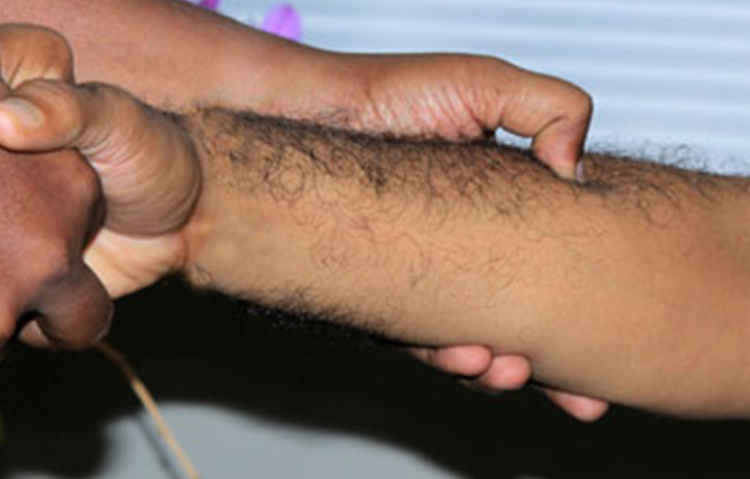
Yogam
Therapy
including vasi yogam (Pranayamam – breath control)
The word ‘Yogam’ means ‘union’. Siddhars have defined yogam as an art which controls the mind by preventing it from
distractions through sense and sense organs and make it concentrating on a
divine work. The regular practice of yogasanams
becomes a kayakalpam and promotes
longevity and youthness.
Vaasi yogam is a branch of science dealing with the practice of controlled breathing which enables one to utilize the oxygen breathed in completely. This method also promotes one’s health and vitality.
In a nutshell, it can be
clearly and strongly stated that Siddha system of medicine deals not only with
curative and preventive health strategy but also directs for promotive health
of the human beings.
References
1. Uthamarayan
CS: Thotrakirama Araichiyum Siddha Maruthuva Varlarum, 3rd edition, Department
of Indian Medicine & Homoeopathy, Chennai, 2003.
2. Uthamarayan,
C.S., Siddha Maruthuvanga Churukkam (2nd Edition), Tamilnadu Arasu Siddha
Ariviyal Membattu kuzhu. Chennai. 1983.
3. Uthamarayan, C.S., A Compendium of Siddha Doctrine: 2005; First edition; Directorate of Indian Medicine and Homoeopathy, Chennai – 106.
4. Sambasivam, T.V., Introduction to Siddha Medicine: 1993; Second edition; Directorate of Indian Medicine and Homoeopathy, Chennai – 106.
5. Shanmugam,S., Siddha Principles of Social and Preventive Medicine, I edition, Directorate of Indian Medicine and Homoeopathy, Chennai – 106.
6. Kandasamy
N, History of Siddha Medicine, second edition, Directorate of Indian Medicine
and Homoeopathy, Chennai, 1998.
7. Shanmugavelu
M. Noi Naadal Noimudhal Naadal, Part 1. 3rd edition. Department of Indian
medicine and Homoeopathy, Chennai.
8. Thiyagarajan
R.,Anandan R, Thulasimani M, Siddha Materia Medica (Mineral & Animal
sections), Directorate of Indian Medicine and Homoeopathy, Chennai, First
edition, 2008.
9. Mohammed
Iqbal, P.A., Pharmacy and Pharmaceutics of Siddha Medicine, First edition,
2016, National Institute of Siddha, Chennai, 2016.
10. Sornamariammal, I., Siddha Marunthukalin Ilakkanamum – vilakkamum, World Siddha Medical trust, Chennai, First edition.
11. Kuppusamy,
K.N., Uthamarayan, C.S., Siddha Vaidya Thirattu (I Edition),Chennai, Department
of Indian Medicine and Homoeopathy. 2009.
12. Thiyagarajan
R.,Anandan R, Thulasimani M, Siddha Materia Medica (Mineral & Animal
sections), Directorate of Indian Medicine and Homoeopathy, Chennai, First
edition, 2008.
13. Murugesan, K.S. Gunapadam – Mooligai Vaguppu, Dept of Indian Medicine & Homeopathy, Chennai. 1988.
14. Sornamariammal,I., Siddha Marunthakkiyal Vithikalum
Seimuraikalum, (1st Edition), Chennai, Department of Indian Medicine
and Homoeopathy. 2010
15. Thirunarayanan T., Introduction to Siddha Medicine, revised
edition, Centre for Traditional Medicine and Research (CTMR), Chennai, 2012.
16. Shanmugavelu P, Natarajan K, Anandan R., Principles of Diagnosis in Siddha part – I, First Edition, Department of Indian Medicine and Homoeopathy. 2009.
17. Uthamarayan, C.S., Siddhar Aruvai
Maruthuvam, II Edition, Tamilnadu Siddha
Maruthuva Variyam, Chennai. 1983.
18. Kalyanasundaram, T.K., Gandhimathy, S., MeenakshiSundaram, M., Siddha Maruthuvam Vol–7; Kuzhandai Maruthuvam, (1st Edition), Tamil Valarchi Kazhakam.
Chennai,2011.
19. Kuppusamy,
K.N., Siddha Maruthuvam, (2nd Edition), Tamilnadu Siddha Maruthuva
Variyam. Chennai, 1987.
20. Sambasivam, T.V., Siddha Tamil Dictionary, Vol.II – Part I, Second edition, 2006, Department of Indian Medicine and Homoeopathy, Chennai.
Author
Dr M Sundaram is a Dr of
Medicine (Siddha-KuzhandaiMaruthuvam)(Paediatrics) from The TN Dr. M.G.R.
Medical University, Chennai. He was awarded Ph.D in Siddha - Paediatrics from
the TN Dr.M.G.R Medical University, Chennai. Currently is working as Professor
and HoD in the Department of Kuzhandhai Maruthuvam in National Institute of
Siddha, Chennai and Dean (i/c) from January 2020 onwards. Dr Sundaram has more
than 25 years of teaching experience which also include 3 years of experience
as Principal in Sri Sai Ram Siddha Medical College, Chennai.
eSamskriti is grateful to Dr Meenakshi Sundaram for writing this piece
and to SMART for co-supporting the eSamskriti effort.